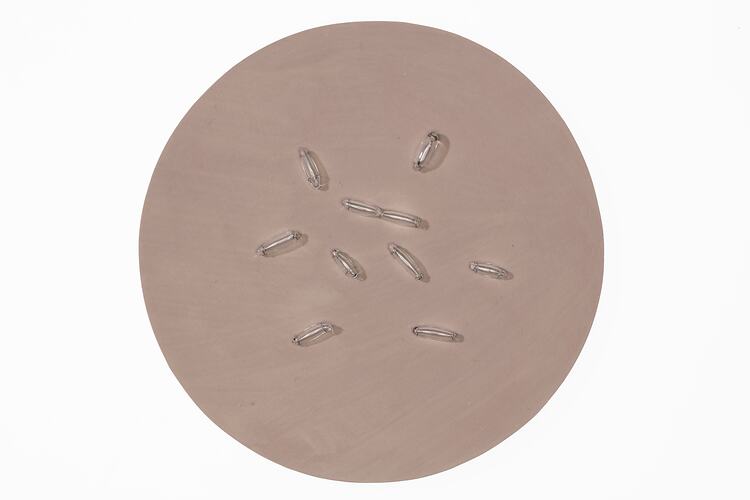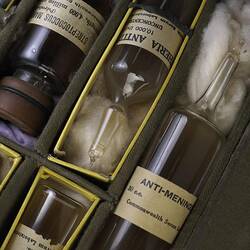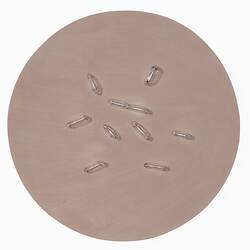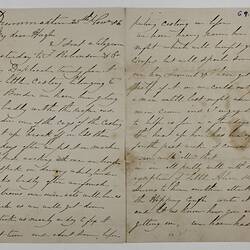Whooping cough (pertussis) is a bacterial respiratory infection that can cause severe coughing to the extent of vomiting. Sufferers can develop a characteristic whooping sound as they cough. It effects very young children severely and can cause death. It is effectively prevented by vaccination, and outbreaks in recent years are associated with low vaccination rates.
The first recognized outbreak of whooping cough occurred in Paris in 1578, described by Guillaume de Baillou. Jules Bordet and Octave Gengou published their findings of whooping cough's causative agent, Bordetella pertussis, in Paris in 1906.
In Victoria, whooping cough was recorded from at least 1841, when The England arrived in July with a whooping cough outbreak which led to the death of 18 passengers. The ship was quarantined while Board of Health doctors undertook enquiries about the outbreak. Other immigrant ships continued to bring whooping cough and other infectious diseases to Victoria, the result of the close proximity of passengers, unsanitary conditions and the boarding of unwell people.
Whooping cough regularly broke out in Victorian communities. The Mount Alexander Mail disparagingly reported in October 1855 that: 'The sanitary condition of the neighbourhood of Melbourne does not appear to be particularly inviting. The scarlatina and whooping cough are said to be very prevalent amongst children located on those hot-beds of disease - the flats of Colling-wood and Richmond, where, notwithstanding their consciousness of its unhealthy, and almost deadly, situation, numbers of families take up their abode in order to save a trifling shilling or two from the pocket of the landlord, while they are compelled to put pounds into the purse of the medical man.'
During the 20th century, whooping cough epidemics in Victoria peaked on average every three years, following a pattern from the 19th century - for example, in the 1890s Victorian councils reported local epidemics in 1890, 1895 and 1899.
Whooping cough vaccination began in Australia during World War II, and a more potent vaccine was released in 1949. The average number of annual deaths in Australia due to whooping cough between 1910 and 1942 was 291, reducing to 16 per year between 1943 (after the introduction of vaccine) and 1996. In the past two decades an average of just two people have died in Australia each year due to whooping cough.
References
Cherry, J.D., 2015. The History of Pertussis (Whooping Cough); 1906-2015: Facts, Myths, and Misconceptions. Curr Epidemiol Rep 2, 120-130. https://doi.org/10.1007/s40471-015-0041-9.
Australian Institute of Health & Welfare, 2018. 'Whooping cough in Australia', 13 Nov.
Kuchar, E., Karlikowska-Skwarnik, M., Han, S. and Nitsch-Osuch, A., 2016. 'Pertussis: History of the Disease and Current Prevention Failure'. Adv Exp Med Biol. 2016;934:77-82. doi: 10.1007/5584_2016_21.
Janet Lee, 'Jules Bordet and the discovery of Bordetella pertussis'. Reprinted from Antimicrobial Therapy, accessed online 11/5/2020.
1841 'Shipping Intelligence.', Port Phillip Patriot and Melbourne Advertiser (Vic. : 1839 - 1845), 19 July, p. 2. , viewed 11 May 2020, http://nla.gov.au/nla.news-article226510672.
1855 'WEEKLY SUMMARY.', Mount Alexander Mail (Vic. : 1854 - 1917), 19 October, p. 3. , viewed 11 May 2020, http://nla.gov.au/nla.news-article202631248.
More Information
-
Keywords
-
Localities
-
Authors
-
Article types




